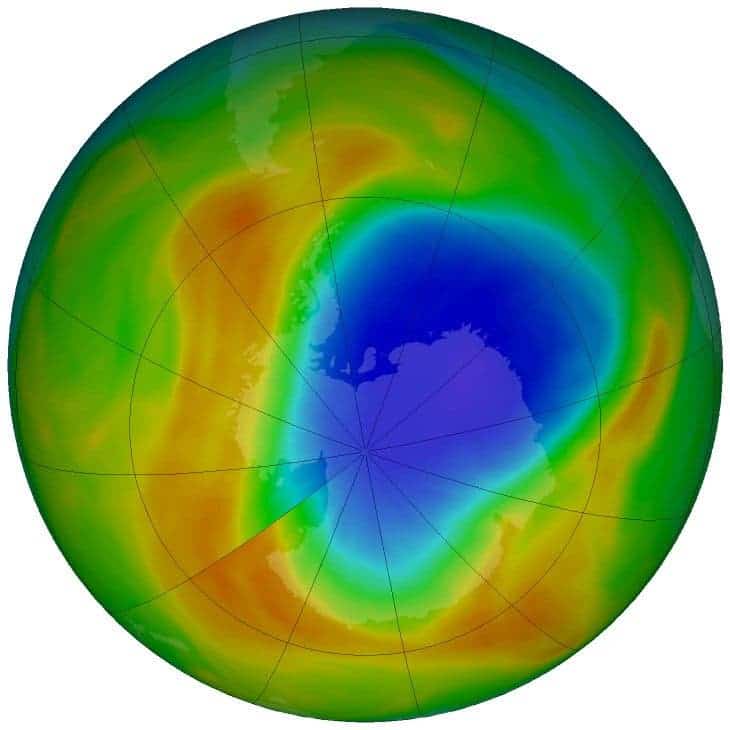The ozone hole over the Antarctic registered its smallest annual peak on record (tracking began in 1982) according to an announcement by the National Oceanic and Atmospheric Administration (NOAA) and NASA on Monday.

Each year, an ozone hole forms during the Southern Hemisphere’s late winter as the solar rays power chemical reactions between the ozone molecules and man-made compounds of chlorine and bromine. Governments around the world are working together to cut down on the ozone-depleting chemicals that created this hole, and it definitely helps.
However, the two agencies warn that we’re still far from solving the problem for good. The small peak in the ozone hole’s surface likely comes from unusually mild temperatures in that layer of the atmosphere seen during this year, they add.
Good but not done
NASA and NOAA explain that the ozone hole consists of an area of heavily-depleted ozone in the upper reaches of the stratosphere. This hole is centered on Antarctica, between 7 and 25 miles (11 and 40 kilometers) above the surface. At its largest recorded size in 2019, the hole extended for 6.3 million square miles (September 8) and then shrank to less than 3.9 million square miles (during the rest of September and October). While that definitely sounds like and is a lot of surface, it’s better than it used to be.
“During years with normal weather conditions, the ozone hole typically grows to a maximum of about 8 million square miles,” the agencies said in a news release.
It’s the third time we’ve seen a similar phenomenon — weather systems slowing down stratospheric ozone loss — take place over in the last 40 years. Below-average spikes in the size of the ozone hole were also recorded in 1988 and 2002.
The stratosphere’s ozone layer helps deflect ultraviolet (UV) radiation incoming from the sun. That’s very good news if you like being alive as UV rays are highly energetic and will cause harm to the DNA of living organisms. UV exposure can lead to skin cancer or cataracts for animals and damages plantlife.
A host of chemicals that used to be employed for refrigeration, including chlorofluorocarbons (CFCs) and hydrofluorocarbons (HFCs), break down ozone molecules in the stratosphere — which exposes the surface to greater quantities of UV. These compounds can last for several decades in the atmosphere and are extremely damaging to ozone during that time, breaking it down in huge quantities.
Humanity bunched together to control the production and release of such chemicals under the Montreal Protocol of 1988, which has drastically reduced CFC emissions worldwide. The ozone layer has been steadily recovering since then, but there’s still a long way to go.
“It’s a rare event that we’re still trying to understand,” Susan Strahan, an atmospheric scientist at the NASA’s Goddard Space Flight Center in Maryland, said in a news release. “If the warming hadn’t happened, we’d likely be looking at a much more typical ozone hole.”
The reactions that break down ozone take place most effectively on the surface of high-flying clouds, but milder-than-average temperatures above Antarctica this year inhibited cloud formation and made them dissipate faster, NASA explains. Since there were fewer clouds to sustain these reactions, a considerable amount of ozone made it unscathed. In a divergence from the norm, NOAA reports that there were no areas above the frozen continent this year that completely lacked ozone.
Warming in the shape of “sudden stratospheric warming” events, were unusually strong this year, NOAA adds. Temperatures in September were 29˚F (16˚C) warmer than usual (at 12 mi/19 km altitude) on average, “which was the warmest in the 40-year historical record for September by a wide margin” according to NASA.
Warmer air weakened the Antarctic polar vortex, a current of high-speed air circling the South Pole that typically keeps the coldest air near or over the pole itself, which slowed significantly (from an average wind speed of 161 mph / 260 kmph to 67 mph / 107 kmph). The slowed-down vortex allowed air to sink lower in the stratosphere, where it warmed and inhibited cloud formation. It’s also likely that it allowed for ozone-rich air from other parts of the Southern Hemisphere to move in.






